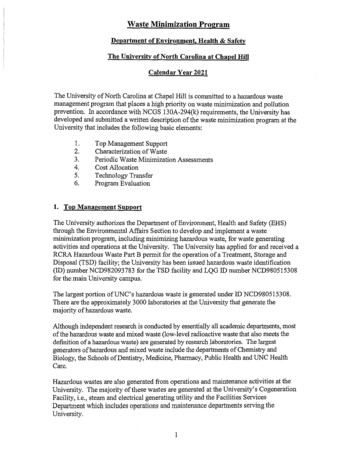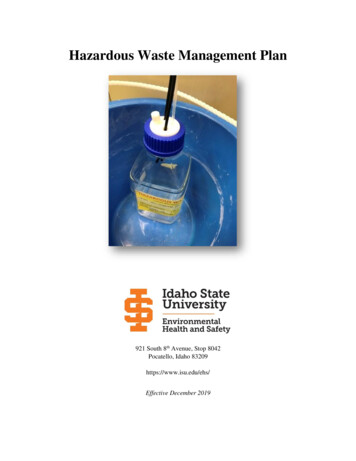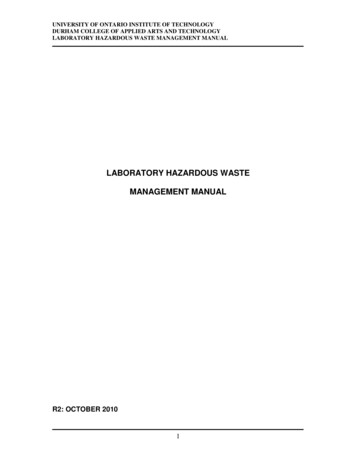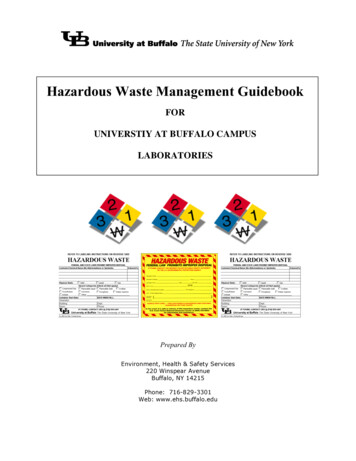
Transcription
Waste Minimization ProgramDepartment of Environment, Health & SafetyThe University of North Carolina at Chapel HillCalendar Year 2021The University ofNorth Carolina at Chapel Hill is committed to a hazardous wastemanagement program that places a high priority on waste minimization and pollutionprevention. In accordance with NCGS 130A-294(k) requirements, the University hasdeveloped and submitted a written description of the waste minimization program at theUniversity that includes the following basic elements:1.2.3.4.5.6.Top Management SupportCharacterization of WastePeriodic Waste Minimization AssessmentsCost AllocationTechnology TransferProgram Evaluation1. Top Management SupportThe University authorizes the Department of Environment, Health and Safety (EHS)through the Environmental Affairs Section to develop and implement a wasteminimization program, including minimizing hazardous waste, for waste generatingactivities and operations at the University. The University has applied for and received aRCRA Hazardous Waste Part B permit for the operation of a Treatment, Storage andDisposal (TSD) facility; the University has been issued hazardous waste identification(ID) number NCD982093783 for the TSD facility and LQG ID number NCD980515308for the main University campus.The largest portion ofUNC's hazardous waste is generated under ID NCD980515308.There are the approximately 3000 laboratories at the University that generate themajority of hazardous waste.Although independent research is conducted by essentially all academic departments, mostof the hazardous waste and mixed waste (low-level radioactive waste that also meets thedefinition of a hazardous waste) are generated by research laboratories. The largestgenerators of hazardous and mixed waste include the departments of Chemistry andBiology, the Schools of Dentistry, Medicine, Pharmacy, Public Health and UNC HealthCare.Hazardous wastes are also generated from operations and maintenance activities at theUniversity. The majority of these wastes are generated at the University's CogenerationFacility, i.e., steam and electrical generating utility and the Facilities ServicesDepartment which includes operations and maintenance departments serving theUniversity.1
EHS developed the Environment, Health and Safety Manual and the Laboratory SafetyManual to serve as an outline for compliance with safety and environmental regulations.Since the primary hazardous waste generators at the University include laboratoryresearch activities, the nature of which is not easily amenable to the establishment ofspecific goals for reduction of waste generation, minimizing hazardous waste generationthrough conventional ways and means becomes more challenging.The Manuals include guidelines for the control of hazardous chemical inventories andsafe handling procedures to aid in reducing waste generation including hazardous wastegeneration. Additionally, the EHS web page {ehs.unc.edu) contains specific informationregarding waste disposal procedures; classroom and computer based waste managementtraining classes, reuse and recycling opportunities and other waste managementinformation such as Safety Data Sheet (SDS) libraries and fact sheets containing practicaltips on waste management and waste minimization.Within EHS, the Hazardous Materials Manager {HMM) serves as the WasteMinimization Coordinator and is responsible for the continued development,implementation and record keeping tasks associated with the waste minimizationprogram. The HMM submits monthly recycling and waste minimization data to theUniversity's Office of Waste Reduction and Recycling {OWRR). This EHS recyclingand waste reduction information is merged with campus-wide recycling data and releasedto the public: lts/2. Characterization of WasteThe HMM coordinates the identification and characterization of waste and manages thetransportation, storage and disposal operations for all regulated waste generated at theUniversity under EPA ID numbers: TSD {NCD 982093783), Waste Transporter{NCD003203213), and the LQG main campus - {NCD980515308).There are four general categories of hazardous wastes that are handled at the TSDFacility- {i) assorted waste solvents, {ii) discarded commercial chemical products, (iii)low-level radioactive mixed wastes and (iv) general chemical wastes.Hazardous wastes generated at UNC-CH are diverse and include almost every hazardclass. However, the majority of the hazardous waste, approximately 80 percent,generated at UNC-CH is described by six EPA RCRA waste codes including: D001(ignitable), F002 (spent halogenated solvents), F003 (spent non-halogenated solvents),FOOS (spent non-halogenated solvents), D008 (toxicity characteristic for lead) and D022(toxicity characteristic for chloroform). The remaining 20 percent of the waste mayinclude toxicity characteristic (D-listed) wastes and discarded commercial chemicalproducts (P- and U-listed) waste.The Waste Analysis Plan for evaluating and characterizing the wastes to ensure thatsufficient information is available for their safe handling and storage can be found inSection C of the University's RCRA permit application.2
3. Periodic Waste Minimization AssessmentEHS advocates the following waste minimization priorities for the generation andmanagement of hazardous wastes: Chemical Substitution-Source ReductionInventory ControlGood Housekeeping-Improved Work PracticesOff-site recyclingAnnually, the University completes the Waste Minimization Questionnaire for SmallQuantity Generators under North Carolina Department of Environmental Quality'sHazardous Waste Section; the response questionnaire lists the waste minimizationstrategies cited above.Chemical Substitution-Source ReductionWaste generators are encouraged to substitute non-hazardous or less hazardous materialsin their research or operations and maintenance activities. This point is emphasizedduring laboratory and facility waste management training sessions and waste storage areainspections. Specific examples of this waste reduction strategy include: Substitution of non-hazardous biodegradable liquid scintillation cocktails forstandard xylene or toluene-based cocktails in research laboratoriesOrganic solvent distillation to reduce volume in the Chemistry Departmentresearch laboratoriesThe exchange and recycling of mercury thermometers for alcohol basedthermometers in the undergraduate Chemistry teaching laboratories and variousresearch laboratories campus-wideInventory ControlWaste generators are required to audit their chemical supplies and use inventory controlon an annual basis and are encouraged to purchase only the quantity of materials requiredfor specific projects or tasks to minimize waste generation. During laboratory cleanoutsand laboratory movement due to building renovations, intra-departmental materialexchanges are encouraged. Within the University's Facilities Services Department,inventory control is widely practiced. A good example of this practice includes theUniversity's service station where bulk oil inventory is limited to purchasing only four55-gallon drums of motor oil at any time instead of eight or more drums of oil. Inaddition, these drums are now stored inside on secondary containment racks whichgreatly reduce the chance of an oil spill.3
Good Housekeeping-Improved Work PracticesAs part of the laboratory safety orientation training program, the University providestraining on its SL's system, i.e., Lids, Leaks, Labels, Locations, and Limits, whichemphasizes concepts that collectively form the basis for minimizing waste generation.Waste generators are instructed to segregate waste, label waste and store materials insecondary containment.Secondary containment minimizes the potential for uncontrolled release of containercontents to the environment and subsequent management of spilled waste materials.Secondary containment can be as simple as using a lipped tray or a bucket that wouldhold the contents of a leaking container. EHS policy states that "Without exception,secondary containment is required for all glass containers of liquid hazardous materialsstored on the floor and all containers with capacity less than or equal to four liters ofliquid hazardous waste, regardless of storage location." Generators are also required tostore hazardous waste at or near the point of generation, keep waste container lids closedexcept to add waste, mark the waste container appropriately, and at all times, wastecontainers are managed and under the control of the waste generator.Off-Site RecyclingOff-site recycling is a major component of the waste minimization program at UNC-CH.An example is the campus-wide battery collection and recycling program for all studenthousing areas. The University' s Waste Minimization Program continues to emphasizethe recycling and retort of mercury containing items by sending such items to a thirdparty recycler whenever and wherever possible. Other waste minimization programsinclude third party recycling of mercury containing fluorescent lamps, High IntensityDischarge (HID) bulbs, compact fluorescent lamps (CFL)'s, non-PCB ballasts, metalshavings, scrap lead, microfilm, non-halogenated solvents and lead-acid batteries.Introduced by the Green Labs Committee in 2013, five-gallon metal cans from selectedbuildings are crushed and recycled.The EHS web page (http://ehs.unc.edu/environmental/recycling) outline the materialscurrently recycled at the University.4. Cost Allocation SystemCurrently the University disposes of hazardous wastes through the TSD facility or, attimes, directly from 3rd party, licensed waste disposal contractors to offsite TSD facilitiesfor treatment and disposal. The University procures annual hazardous waste contractswith fixed price schedule ofvalues. Five experienced, hazardous waste disposalcompanies are currently included in the University's waste disposal contracts. Thesevendors include Tradebe, Veolia, Stericycle, Bionomics and Clean Harbors. There areapproximately 3000 research laboratories at the University and waste disposal fees aregenerally paid for indirectly through overhead receipts.Under certain circumstances, an exceptional laboratory clean-out, facility maintenance orbuilding renovation, waste disposal costs may be billed directly to the generating project.4
In recent years, hazardous waste management costs, including disposal costs, have beenpaid directly by individual major construction projects.As a waste identification and waste characterization tool for renovation/constructionprojects, EHS personnel have conducted Toxicity Characteristic Leaching Procedure(TCLP) sampling and analysis for potential lead and mercury containing buildingmaterials with sampling results allowing the project designer to determine the mostappropriate removal, waste management and waste disposal methods. EHS personnel arealso utilizing the Ohio-Lumex RA-915 Mercury Analyzer, and the X-Ray Fluorescence(XRF) lead analyzer to assist the project designer in determining what demolition debrisis impacted by mercury or lead contamination as well as the most appropriate wastedisposal methods for mercury or lead waste and debris.Specific cost and recycling activity information are maintained by the HMM and updatedmonthly.5. Technology TransferThe University EHS department takes a proactive role in reducing the quantity anddegree of hazard/toxicity of hazardous waste generated at the University. Wastereduction and hazard minimization are key topics in the training orientation of newlaboratory and facility employees. Information to assist the University community inachieving waste reduction and hazard minimization can be found on the EHS web page.Representative examples include waste management and safety fact sheets, in-person andon-line training classes, on-line waste management and disposal procedures, andlaboratory close out procedures. During Collaborative Laboratory Inspection Program(CLIP) and Hazardous Management Program (HMP) inspections, waste minimizationopportunities are discussed with waste generators.EHS is an active member of the Campus Safety, Health and Environmental ManagementAssociation (CSHEMA), the College & University Hazardous Materials Managementassociation (CUHMM), the Campus Consortium for Environmental Excellence (C2E2)and the Alliance of Hazardous Materials Professionals (AHMP). Through these and otheracademic and scientific/trade associations, the University has many opportunities to seekand exchange technical information on waste management and waste minimizationstrategies and techniques.6. Program EvaluationThe waste minimization program at the University continues to evolve. A few of thecurrent efforts by EHS and the University to improve the waste minimization programare listed below: Intradepartmental chemical exchanges during laboratory clean-outs andrelocations.Just-in-time purchases of bulk oil at the Service Station and of non-bulk chemicaland lubricants at the Cogeneration Facility are on-going.5
A campus-wide battery recycling program that includes student housing. A totalof 2,975 kg oflarge, car-type lead-acid batteries from the Service Station wererecycled through Battery Tree.Recycling of printed circuit boards, lamp ballasts, computer electronic equipment,X-ray, photo processing and microfiche film, film fixer solvents, lead and silversolder, mercury dental amalgam, empty 5-gallon metal cans, and universal wastemercury lamps.Recycling Totals9,790 kg mercury lamps15 kg Microfiche/Microfilm21 kg Dental Amalgam1,226 (2,558kg) empty 5-gallon metal cans 6,445 gallons ofbulked organic solvents sent for energy recovery instead ofdisposal.Lead scrap materials and non-PCB ballasts recycling.Recycling Totals2,485 kg Non-PCB Ballasts685 kg of Lead Used oil recycling is free for the University and under state contract. Training isconducted campus-wide to educate used oil producers not to mix other waste withused oil, especially solvents. 810 gallons ofoil were recycled from the ServiceStation).Replacement of ignitable, toxic scintillation fluids with non-hazardousbiodegradable solutions is an on-going project as part of the CLIP and HMPinspection programs.Attendance of various University departments and Facilities Services Departmentat meetings to communicate waste minimization and recycling efforts. Theseactivities include the following:Lab meetings by requestLab Move Team for campus areas5-gallon metal can recyclingSeveral venues to solicit user feedback are in place for periodic evaluation of theprogram. These include various sections of EHS, OWRR and the UniversitySustainability Office, surveys from individual laboratories and a direct email link to theEHS Executive Director, Cathy Brennan:http://ehs.unc. edu/about/feedback/As additional waste minimization opportunities arise during major University buildingconstruction and renovation projects, cooperative efforts with OWRR and buildingcontractors will be developed to reduce/reuse/recycle materials.6
UNC-CHAPEL HILL -Recycling Totals: CY 2020Recycled Materials CY 2021Iii SolventsIii Florescent TubesIii Metal Solvent CansIll Non-PCB Ballasts LeadIii Lead-Acid BatteriesRecycled MateriaIs CY 2020Iii SolventsIii Florescent TubesIii Metal Solvent CansIii Non-PCB Ballasts LeadIii Lead-Acid Batteries7
Mercury Lamps:Florescent Lamps, U-Tubes, HID bulbs and Mercury Vapor Lamps recycled by do/waste-capabilities/mercury-waste recyclingMercury Lamps Recycled200001800016000140001200010000 Kilograms-800060004000- 2000-t-0Non-Halogenated Solvents:Solvents are shipped by Clean Harbors or Tradebe by tanker to their facilities forrecycling (Fuels Blending): services/techni cal-services/recycling-services/ chemical t/energy-recovery-fuels-blending8
Non-Halogenated Solvents Recycled12000 , - - - - - - - - - - - - - - - - - - - - - - - - - -6000-i------------------------- ----- --------------------4000-ra-1--1----- -------1-1----------.1-1----------2000----------- 1--111-11000080000 Gallons1--111-11-11--11 -"''--r-"""-,---.----.,.- ,.,., ,---,.-. ,.-.-., .---,.--.----.-------.---.---.--.-.mN00 00N00NN 00N 00N 00Nooom00n00N0NNnmNM0M0NM0NN M0N n0M0NN n0NooM0NmoNNn0N0nN0NNon-PCB Ballasts/Lead: Lee Iron and Metal Co., Sanford, NCTable 1 Lead and Non-PCB Ballasts Recycled18000162151600014000 136101200010022100007,1J (l80006841366025 02000 1 0 Brass5825::;195--::--4000I'.o- 82 11: 174SEII,J.'"1-31I I' - I 248519 095 6]I23CII 09.CLead Non-PCB Ballasts., 3-i o3,b98b675057636000 855 878795471'68II
Lead-acid batteries: Shipped out of UNC's TSD by Battery Tree; 2,835 kg recycledhttps://www.batterytree.net/Batteries: AAA, AA, Ni-cad, Lithium1,325 kg recycled by al-wasteUsed Oil Recycled by State Contract: US Filter Recovery Systems, 285 gallons ofvarious oils were recycled from UNC's TSD.https ://www.cl eanharbors. corn/services/techni cal-servi ces/recycling-servi ces/used-oi l and-oi1-products-recyclingPhoto processing:X-ray, Microfiche, Microfilm-38 kgPhoto Fixer with Silver-121 kgSilver Trap-X-ray Film Developer-18 kgAmalgam-18 kg10
WASTE MINIMIZATION CERTIFICATIONPursuant to 40 CFR 264.73(b)(9) as adopted in 51A NCAC 13A .0109 and section 3005(h) ofRCRA, 42U.S.C. 6925(h), The University of North Carolina at Chapel Hill certifies, no less often than annually that:I.The Department of Environment, Health, and Safety (EHS) has a program in place to reducethe volume and toxicity of hazardous waste to a degree determined by the EHS Director to beeconomically practicable; and2.The proposed method of treatment, storage or disposal is the most practicable methodavailable to the University which minimizes the present and future threat to human health andthe environment.CERTIFICATION STATEMENT;I certify that the information contained in the Waste Minimization Program for the University of NorthCarolina at Chapel Hill is true, accurate and complete.lo-ooG./11Date 1Steve ParkerHazardous Materials ManagerDepartment of Environment, Health and SafetyCathy Brennanift-"cff-- ,r Executive Director"·Department of Environment, Health and Safety11
The Manuals include guidelines for the control ofhazardous chemical inventories and safe handling procedures to aid in reducing waste generation including hazardous waste generation. Additionally, the EHS web page {ehs.unc.edu) contains specific information . regarding waste disposal procedures; classroom and computer based waste management










